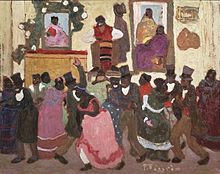
Back كاندومبى ARZ Candombe Breton Candombe Catalan Candombe DAG Candombe German Candombe DGA Candombe Spanish Candombe Basque کاندومبه Persian Candombe Finnish
| Candombe | |
|---|---|
 Painting of a crowd participating in a candombe | |
| Cultural origins | Bantu peoples |
| Typical instruments | Candombe drums |
| Subgenres | |
| |
| Candombe and its socio-cultural space: a community practice | |
|---|---|
| Country | Uruguay |
| Reference | 00182 |
| Region | Latin America and the Caribbean |
| Inscription history | |
| Inscription | 2009 (4th session) |
| List | Representative |
Candombe is a style of music and dance that originated in Uruguay among the descendants of liberated African slaves. In 2009, the United Nations Educational, Scientific and Cultural Organization (UNESCO) inscribed candombe in its Representative List of the Intangible Cultural Heritage of Humanity.[1]
To a lesser extent, candombe is practiced in Argentina, Paraguay, and Brazil. In Argentina, it can be found in Buenos Aires, Santa Fe, Paraná, and Corrientes. In Paraguay, this tradition continues in Camba Cuá and in Fernando de la Mora near Asunción. In Brazil, candombe retains its religious character and can be found in the states of Minas Gerais and Rio Grande do Sul.
This Uruguayan music style is based on three different drums: chico, repique, and piano drums. It is usually played in February during carnival in Montevideo at dance parades called llamadas and desfile inaugural del carnaval.
- ^ "Candombe and Its Socio-Cultural Space: A Community Practice". UNESCO Intangible Cultural Heritage. 2009. Retrieved January 18, 2020.